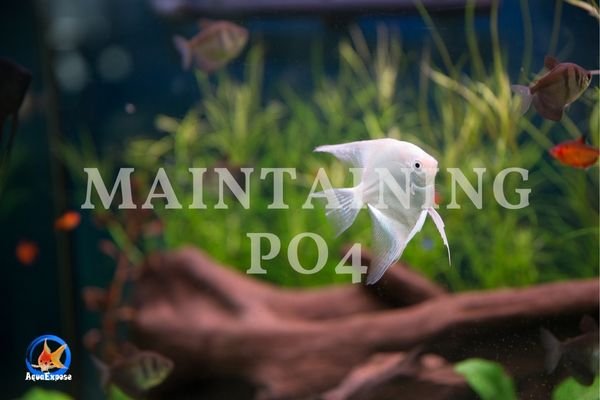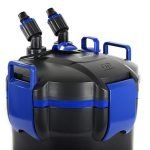How Does Water Acquire Phosphate & How To Maintain Low Levels Of Phosphate In Aquarium Water?

Aquarium water is an essential part of any fish tank, and phosphate is one of the vital minerals it needs to stay healthy. But why does aquarium water need phosphorus in the first place? And how can you ensure that your water supply has a healthy phosphate level? This blog explores these questions in detail and provides tips on keeping phosphate levels low in your aquarium water without resorting to unorthodox methods. By following these simple tips, you can create a healthy aquatic environment for your fish while ensuring they get all the essential minerals they need.
Phosphates are essential for the growth and development of fish. Too much phosphorus in the water can lead to problems like algae blooms, calcium buildup in tissue, and even toxicity. Phosphorus levels should be kept low without resorting to artificial methods by following a few simple tips:
1) Remove organic matter and other pollutants from your water before adding it to your tank – this will help reduce phosphorus.
2) Adjust pH if necessary – high pH values promote algae growth, which is why to adjust some.
Sources of phosphorus in water
Phosphorus is an essential mineral in aquatic ecosystems and for the growth of aquatic plants and animals. However, phosphorus can be a pollutant and cause water toxicity in aquariums. It is essential to know where phosphorus comes from in the water and how to remove it before it causes problems.
Phosphorus can come from many sources, including organic matter, fecal material, and other pollutants. So, keep phosphorus levels in check by knowing where it comes from and how to remove it! It’s crucial to remove phosphorus before the water enters the aquarium – this is done by using a phosphate remover or carbon filter. If phosphorus levels are high, change the water regularly or add activated carbon to help reduce phosphates.
Phosphate sources at a glance:
- Uneaten food
- Plant decay
- Dying algae
- Fish feces
- Dead fish
- Carbon filter media
- Aquarium salts
- pH buffers
- kH buffers
- Tap water
Phosphate Desired Level in Fish Tank:
The ideal Phosphate Desired Level in the fish tank is around 1.5 to 2.0 mg/L, but the actual level will vary depending on the size and type of fish tank, water temperature, and other factors. It’s important to keep an eye on this number because if it rises too high (above 2.0 mg/L), it can cause the death of fish or, worse yet, algae growth that could contaminate your water supply with harmful chemicals.
[ To check your aquarium water regularly, and use some best water test kits.]
How does aquarium water acquire phosphate?
Aquarium water acquires phosphate from the fish and plants in the aquarium. This process is regulated by a specialized enzyme called carbonate phosphatase. Monitoring these enzymes and adjusting water changes as needed is essential to keep phosphate levels low. Phosphate can be detrimental to aquatic life, so it’s important to avoid high levels in aquarium water. Remember that water changes are essential to keeping your aquarium healthy and phosphate levels at a low, safe level.
Phosphates are found in many common substances-
Phosphates are essential for plant growth and fish health. Aquarium water acquires phosphate when these substances are broken down by the bacteria present in the water. It is, therefore, important to keep phosphate levels low, especially if you want healthy algae growth and healthy fish! There are a few ways to achieve this: feeding your fish a high phosphate diet or using a water conditioner that reduces phosphate levels.
Phosphates are used to make fertilizers
Aquariums and fish tanks rely on phosphate fertilizer to provide essential nutrients to their aquatic inhabitants. Phosphates are necessary for plant growth but can also be toxic in high doses. To avoid harmful levels of phosphorus in aquarium water, you need a filter that quickly removes waste particles before reaching the aquarium. In addition, it is crucial to keep the waste level down by adding proper fertilizer regularly and avoiding overfeeding your fish.
How does water acquire phosphate?
Water acquires phosphate through rainfall, water runoff, and groundwater. Phosphate is essential for plant growth, and phosphorus-deficient soil can lead to stunted or dead plants.
Why is phosphorus important for fish tank water?
Phosphorus is a vital nutrient for fish and is especially important for those who keep fish in aquariums. Phosphorus helps to build muscle, bones, and scales, and it also helps to maintain water quality. Phosphorus levels in fish tank water can be high, but this can damage fish tissue and cause illness or death. It’s important to keep phosphorus levels low by recycling water daily and adding a phosphate remover if needed. Aquariums with high-quality water typically have lower phosphorus levels than those with poor water quality. So, to keep fish in your tank, check the water quality first and add the appropriate treatments as needed.
Phosphates are essential for plant growth and survival for fish.
Most of us know phosphate is an essential nutrient for plant growth and survival, but did you know it’s also vital for fish? Phosphates are necessary for fish to survive and thrive in aquarium water. It helps produce proteins, phosphorus-containing compounds, and nucleic acids. However, to keep your fish healthy and happy, it’s important to maintain low phosphate levels in your aquarium water.
You can use a few methods to achieve this goal, but the most effective is usually using a phosphorize, marine salt, or treating your tap water with an enzyme cleaner. All these methods work well but vary in effectiveness, so be sure to try several before settling on one that suits your needs best!
A healthy aquarium water supply needs minerals like phosphate.
A healthy aquarium water supply needs minerals like phosphate. This phosphorus is acquired from the food fed to your fish or coral. If levels of phosphorus in aquarium water get too high, it can lead to problems like cloudy water, stunted growth, and even death for your fish or coral. You can do a few things to maintain low phosphorus levels in your tank’s water supply. Feed only frozen food; make sure there are enough organic detritus (fertilizer) available for plankton; adjust the pH level if necessary; add sea salt (as opposed to regular table salt), and perform routine partial water changes. Knowing how to keep an aquarium’s mineral content in check will help ensure a healthy environment for your aquatic creatures!
Ways to maintain low levels of phosphate in aquarium water
Phosphate is a mineral that’s essential for plant growth. However, it can become a problem when it accumulates in water aquariums to high levels. There are several ways to reduce phosphate levels in aquarium water. Monitoring the pH and adjusting water chemistry as needed is essential in ensuring low phosphate levels.
One way to achieve low phosphate levels is by increasing the water’s magnesium content. This can be done by adding magnesium supplements or using a Magnesium Water Treatment Device. Other methods that can be used include carbon filtration, activated carbon, and adsorption/desorption processes. It’s essential to keep in mind that phosphate levels can fluctuate, and it’s important to monitor the aquarium pH and adjust the water chemistry as needed for low phosphate conditions to persist.
Reducing Phosphate
The best way to reduce phosphate in your aquarium is never to let it get high in the first place. If your phosphate is already too high, however, you can reduce it by taking the following steps:
Water Change: Every week or two, make a water change of at least 50% to help remove any phosphate that may have accumulated in your aquarium.
Feeding: Feed only frozen food, as fresh food will release phosphorus into the water. Make sure enough organic detritus (fertilizer) is available for plankton growth; adjust the pH level if necessary; add sea salt (rather than table salt), and perform routine partial water changes.
Tank Cleaning: Regular tank cleanings will help remove any phosphate buildup in the water.
Water pH: Adjusting your aquarium’s water chemistry can also help to reduce phosphorus levels. If your phosphorus level is high, you may need to adjust the tank’s water pH level using a buffer such as potassium bicarbonate or sodium hydroxide.
Managing Your Phosphate Levels
To manage phosphate labels in aquariums, It’s important to keep track of both your aquarium’s phosphorus level and water pH. If your phosphorus level is consistently high, you may need to adjust the water pH level to reduce its levels. However, it’s important to keep in mind that phosphate levels can fluctuate, and it’s always best to monitor both your aquarium’s phosphorus level and water pH frequently for low phosphate conditions to persist.
Frequently Asked Questions
Why is my aquarium water high in phosphate?
Aquarium water is typically high in phosphorus because of the fertilizer many fish owners put into their tanks. Phosphate can build up in an aquarium if it’s not monitored and levels are kept low. To keep your aquarium water low in phosphorus, you’ll need to feed your fish a diet low in phosphorus or use a phosphating powder to add to their food.
What are some methods for treating aquarium water with low phosphate levels?
There are a few methods that can be used to treat aquarium water with low phosphate levels, but it is important to choose the right one for your tank and fish. These methods include adding activated carbon, using an Epsom salt kit, or feeding live aquatic plants. It is also advisable to keep track of your nitrates and phosphates levels so you can adjust your treatment accordingly.
What are some potential side effects of using phosphorus-reducing treatments in fish tanks?
Some potential side effects of phosphorus-reducing treatments in the fish tank include making your fish sick and causing a drop in water pH, which can lead to algae growth and corrosion. To avoid these problems, add Epsom salts or baking soda to your aquarium water to help maintain low phosphate levels.
Conclusion
Phosphates are essential for plant growth and survival in fish tanks. Aquarium water containing high phosphate levels can cause fish to become sick and plants to wilt. Follow the steps listed in this blog to maintain a healthy aquarium water supply that is low in phosphate. Check back for more helpful tips on keeping your aquarium water supply healthy!

